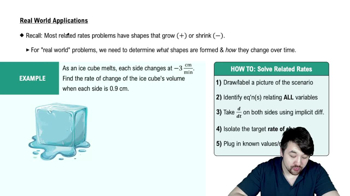Table of contents
- 0. Functions7h 52m
- Introduction to Functions16m
- Piecewise Functions10m
- Properties of Functions9m
- Common Functions1h 8m
- Transformations5m
- Combining Functions27m
- Exponent rules32m
- Exponential Functions28m
- Logarithmic Functions24m
- Properties of Logarithms34m
- Exponential & Logarithmic Equations35m
- Introduction to Trigonometric Functions38m
- Graphs of Trigonometric Functions44m
- Trigonometric Identities47m
- Inverse Trigonometric Functions48m
- 1. Limits and Continuity2h 2m
- 2. Intro to Derivatives1h 33m
- 3. Techniques of Differentiation3h 18m
- 4. Applications of Derivatives2h 38m
- 5. Graphical Applications of Derivatives6h 2m
- 6. Derivatives of Inverse, Exponential, & Logarithmic Functions2h 37m
- 7. Antiderivatives & Indefinite Integrals1h 26m
- 8. Definite Integrals4h 44m
- 9. Graphical Applications of Integrals2h 27m
- 10. Physics Applications of Integrals 2h 22m
4. Applications of Derivatives
Related Rates
Problem 107b
Textbook Question
Suppose the cost of producing x lawn mowers is C(x) = −0.02x²+400x+5000.
b. Interpret the meaning of your results in part (a).
 Verified step by step guidance
Verified step by step guidance1
To interpret the meaning of the results from part (a), we first need to understand the function C(x) = −0.02x² + 400x + 5000. This function represents the cost of producing x lawn mowers.
The term −0.02x² indicates that the cost function is quadratic, and the negative coefficient suggests that the cost increases at a decreasing rate as more lawn mowers are produced. This is typical of economies of scale where producing more units can reduce the average cost per unit.
The term 400x represents the linear component of the cost function, which implies that there is a direct cost associated with each lawn mower produced. This could include materials, labor, and other variable costs.
The constant term 5000 represents fixed costs, which are costs that do not change with the number of lawn mowers produced. These could include rent, salaries of permanent staff, and other overheads.
In part (a), you likely found the derivative of C(x) to determine the marginal cost, which is the cost of producing one additional lawn mower. Interpreting this result helps understand how the cost changes with production levels and can inform decisions on optimal production quantities.
 Verified video answer for a similar problem:
Verified video answer for a similar problem:This video solution was recommended by our tutors as helpful for the problem above
Video duration:
5mPlay a video:
Was this helpful?
Key Concepts
Here are the essential concepts you must grasp in order to answer the question correctly.
Cost Function
A cost function, such as C(x) = -0.02x² + 400x + 5000, represents the total cost of producing a certain number of goods, in this case, lawn mowers. It typically includes fixed costs and variable costs, where the quadratic term indicates that costs may increase at a decreasing rate after a certain production level.
Recommended video:

Properties of Functions
Derivative and Marginal Cost
The derivative of the cost function, C'(x), provides the marginal cost, which is the cost of producing one additional unit. Understanding this concept is crucial for interpreting how production levels affect costs and for making decisions about scaling production.
Recommended video:

Derivatives
Interpretation of Results
Interpreting results involves analyzing the output from the cost function and its derivative to understand the economic implications. This includes assessing how changes in production volume impact overall costs and profitability, which is essential for making informed business decisions.
Recommended video:

Integrals Resulting in Basic Trig Functions Example 1
Related Videos
Related Practice






